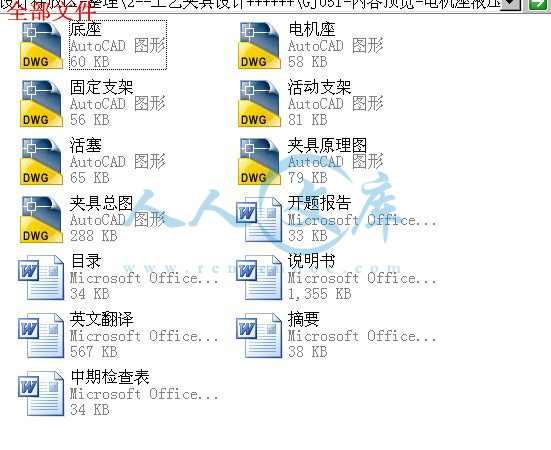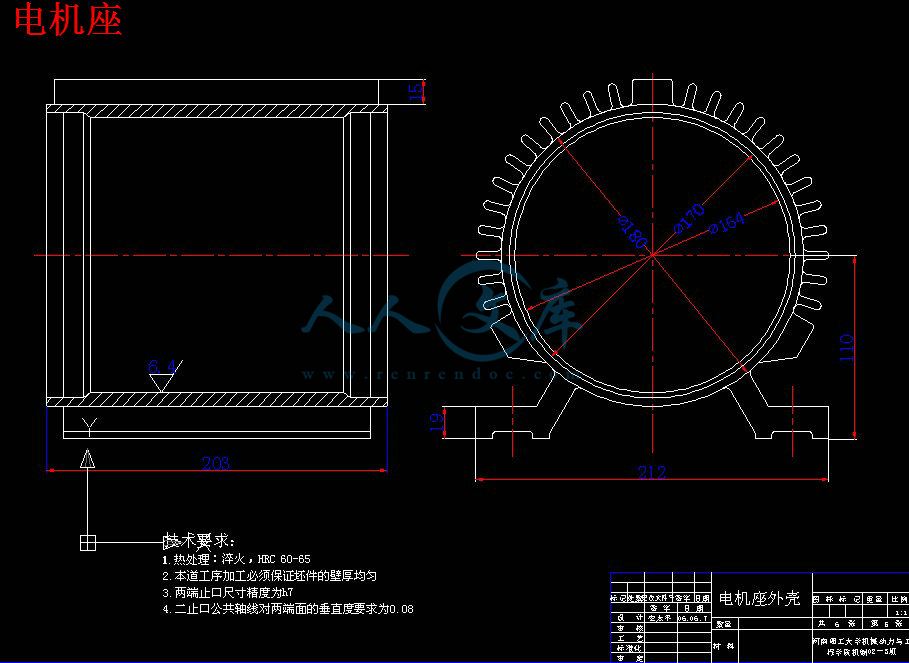摘要
二十一世纪的制造业面临着顾客需求驱动、不可预测、快速多变和来自全球不断增加的市场竞争,而且竞争不断加剧。市场的不断变化要求制造系统加工的产品品种能够快速变换以满足市场需求。近来的制造业发展表明,夹具能比较好的满足上述要求并符合我国国情。作为制造系统重要组成部分的夹具设计部分,制造系统对其提出了新的要求。夹具在机械加工起着重要的作用,它直接影响着机械加工的质量,生产效率和成本,因此夹具设计是机械工艺准备和施工中的一项重要工作。
这篇毕业设计主要阐述的是一套关于电机座液压夹紧粗镗夹具的设计方法,这种夹具主要应用于电机座的粗镗工序,通过这个夹具可以保证电机座粗镗后的加工要求和达到提高生产效率的目的。
在说明书中,首先明确了设计任务并对夹具作了相关的阐述,接着根据电机座的加工工序提出了镗床夹具的设计方法和理论,并依据这些方法和理论对夹具进行设计和校核、验算。最后对夹具中某些典型或重要的零件进行了介绍和校核。这种设计方法代表了镗模的一般设计过程,对其他夹具的设计工作也有一定的价值。
关键词:夹具、电机座、工序
Abstract
Manufacturing companies in the 21s' century will face unpredictable, high-frequency market changes driven by global competition. The continuous changes of market require a rapid change of product varieties in order to meet the market demands. Recent surveys have showed that fixture are the cornerstones of this new manufacturing paradigm. Fixture is also suitable to our country. After reconfiguration manufacturing system puts new requirements on fixture design, an important component of the traditional manufacturing system. Fixture is very important equipment in process of machine manufacturing because it can directly affect the quality of products and productivity and cost. So fixture designing is also a base portion in machine process.
This paper of graduation mainly presents a systematic approach for the design of Electrical Block hydraulic upholding tool rough noise of drums .this upholding tool are mainly used in the working procedure of Electrical Block hydraulic rough noise of drums . It can accomplished the purpose what this fixture can be satisfy after Electrical Block hydraulic upholding tool rough noise of drums produce demand and approach to improve production efficiency.
First ,we define the design of assignment and represent something about fixture. The next ,Accordingly to the processing of workpiece of motor cabinet ,we extract the method and way of boring lathe of fixture. And then ,we practice into design the fixture according to the method and way .After this design ,we take some canonical workpiece for example to check the strength.. The method of this fixture represent the process of canonical fixture. Of course ,the design of our fixture also can guide the design of fixture.
目录
前言………………….........................................................................................1
第1章 毕业设计的目的和任务……..………...…………………...2
1 毕业设计的目的………………………………………………………………2
2 毕业设计的任务……………………………………………….………………2
第2章 夹具方案设计
1 夹具的概述及作用………….………………………………………………4
1.1 夹具的概念…...............…..………………………………………………...4
1.2 夹具的作用………………………………...……………………………..…5
2 夹具设计的一般步骤
2.1 设计前的准备工作……………………………………………………….…6
2.2 拟定夹具结构方案、绘制工件工序图………….………………………....7
2.3 确定夹具的结构方案……………………………………………………….8
2.4 夹具体的设计………………………………………………………13
3 绘制夹具结构草图
3.1 布置图面……………………………………………………………………15
3.2 设计定位夹紧元件…………………………………………………..……..16
3.3 夹具的精度计算……………………………………………………………18
3.4 夹紧力(矩)的验算……………………………….………………..…….19
3.5 绘制夹具总图………………………………………………………...…….28
3.6 尺寸标注与公差配合……………………………………………………....29
3.7 液压传动原理…………………………………………………………...….32
3.8 夹具总体设计中须注意的问题……………………………………..……33
第3章 典型零件介绍…………………………...………………..….44
总结……………………………………………………………..……………..48
致谢……………………………………………………………………………49
参考文献…………………………………………………………………….50
前 言
四年的大学生活马上就要结束了,我们也进入了大学生活的最后一个阶段——毕业设计。毕业设计是对我们四年来所学知识的大总结和测验我们对所学知识的掌握,也是向我们今后即将从事的工作的正常过渡。设计的正确程度也标志着我们四年来对所学知识的掌握和熟练运用程度。
四年来,在我院老师及领导的精心关怀和指导下,我学习了机械设计制造与设备专业的有关知识,同时也了解了一些相关学科的基本情况,为毕业设计打下了坚实的基础。
我们这次设计的题目是《电机座液压夹紧夹具》。我所设计的部分主要是夹具部分主要是夹具方面,对液压涉及的比较少,只是在典型零件介绍中简要提了 一下。图书馆中对这一方面的资料还是又不少相关资料,但是重复很多而且计算很少。通过整个设计过程,让我懂得了只有阅读大量的有关知识,触类旁通,精密构思与计算,仅仅靠所学的知识是远远不能解决设计过程中所遇到的难题,通过实习和在院先进制造研究所的观察和分析,对电机座的加工工艺有了一个初步了解。综合以上各种材料,得出了现在比较满意的结果。在姜无疾老师的辛勤指导下和同组同学的帮助下,我的这次设计取得了基本成功。
本次设计可以说是对所学知识的综合运用,也是第一次单独面对这样庞大的设计工作。鉴于本人水平有限,经验不足,设计中难免有不足之处,请各位老师同学批评指正。





 川公网安备: 51019002004831号
川公网安备: 51019002004831号